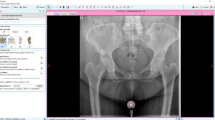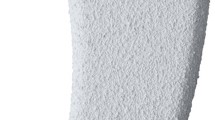Abstract
Introduction
Modern total hip arthroplasty is largely dependent on the successful preservation of hip geometry. Thus, a successful implementation of the preoperative planning is of great importance. The present study evaluates the accuracy of anatomic hip reconstruction predicted by 2D digital planning using a calcar-guided short stem of the newest generation.
Methods
A calcar-guided short stem was implanted in 109 patients in combination with a cementless cup using the modified anterolateral approach. Preoperative digital planning was performed including implant size, caput–collum–diaphyseal angle, offset, and leg length using mediCAD II software. A coordinate system and individual scale factors were implemented. Postoperative outcome was evaluated accordingly and was compared to the planning.
Results
Intraoperatively used stem sizes were within one unit of the planned stem sizes. The postoperative stem alignment showed a minor and insignificant (p = 0.159) mean valgization of 0.5° (SD 3.79°) compared to the planned caput–collum–diaphyseal angles. Compared to the planning, mean femoral offset gained 2.18 (SD 4.24) mm, while acetabular offset was reduced by 0.78 (SD 4.36) mm during implantation resulting in an increased global offset of 1.40 (SD 5.51) mm (p = 0.0094). Postoperative femoroacetabular height increased by a mean of 5.00 (SD 5.98) mm (p < 0.0001) compared to preoperative measures.
Discussion
Two-dimensional digital preoperative planning in calcar-guided short-stem total hip arthroplasty assures a satisfying implementation of the intended anatomy. Valgization, which has been frequently observed in previous short-stem designs, negatively affecting offset, can be avoided. However, surgeons have to be aware of a possible leg lengthening.




Similar content being viewed by others
References
von Lewinski G, Floerkemeier T (2015) 10-year experience with short stem total hip arthroplasty. Orthopedics 38:S51–S56
Jerosch J, Grasselli C, Kothny P (2012) Veränderungen von Offset, CCD-Winkel und Beinlänge nach Implantation einer metadiaphysär fixierten Kurzschaftprothese–eine radiologische Untersuchung. Zeitschrift Für Orthopädie Und Unfallchirurgie 150(1):20–26
Babisch J (2013) Möglichkeiten der patientenindividuellen Hüftgelenkrekonstruktion und Knochenresektion bei Kurzschaftprothesen. In: Jerosch J (ed) Kurzschaftendoprothesen—Wo liegen die Unterschiede?. Deutscher Ärzte-Verlag, Köln
Höhle P, Schroeder SM, Pfeil J (2015) Comparison between preoperative digital planning and postoperative outcomes in 197 hip endoprothesis cases using short stem prostheses. Clin Biomech 30:46–52
Della Valle AG, Comba F, Taveras N, Salvati EA (2008) The utility and precision of analogue and digital planning for total hip arthroplasty. Int Orthop 32:289–294
Hossain M, Lewis J, Sinha A (2008) Digital pre-operative templating is more accurate in total hip replacement compared to analogue templating. Eur J Orthopaed Surg Traumat 18:577–580
Iorio R, Siegel J, Specht LM, Tilzey JF, Hartman A, Healy WL (2009) A comparison of acetate vs digital templating for preoperative planning of total hip arthroplasty: Is digital templating accurate and safe? J Arthroplasty 24:175–179
Matsushita A, Nakashima Y, Jingushi S, Yamamoto T, Kuraoka A, Iwamoto Y (2009) Effects of the femoral offset and the head size on the safe range of motion in total hip arthroplasty. J Arthroplasty 24:646–651
McCabe JP (1998) Dislocation following total hip arthroplasty. Curr Opin Orthop 9(1):9–13
McGrory BJ, Morrey BF, Cahalan TD, An KN, Cabanela ME (1995) Effect of femoral offset on range of motion and abductor muscle strength after total hip arthroplasty. J Bone Joint Surg (Br) 77:865–869
Yamaguchi T, Naito M, Asayama I, Ishiko T (2004) Total hip arthroplasty: the relationship between posterolateral reconstruction, abductor muscle strength, and femoral offset. J Orthop Surg (Hong Kong) 12:164–167
Charles MN, Bourne RB, Davey JR, Greenwald AS, Morrey BF, Rorabeck CH (2005) Soft-tissue balancing of the hip: the role of femoral offset restoration. Instr Course Lect 54:131–141
Boese CK, Dargel J, Oppermann J, Eysel P, Scheyerer MJ, Bredow J, Lechler P (2016) The femoral neck-shaft angle on plain radiographs: a systematic review. Skelet Radiol 45:19–28
Pfeil J (2010) The anterolateral approach with the patient in supine position. In: Pfeil J, Siebert WE (eds) Minimal invasive surgery in total hip replacement. Springer, Heidelberg, pp 63–78
Davilla JA, Kransdorf MJ, Duffy GP (2006) Surgical planning of total hip arthroplasty: accuracy of computer-assisted EndoMap software in predicting component size. Skelet Radiol 35:309–393
Della Valle AG, Slullitel G, Piccaliga F, Salvati EA (2005) The precision and usefulness of preoperative planning for cemented and hybrid total hip arthroplasty. J Arthroplasty 20:51–58
Suh KT, Cheon SJ, Kim DW (2004) Comparison of preoperative templating with postoperative assessment in cementless total hip arthroplasty. Acta Orthop Scand 75:40–44
Austin MS, Hozack WJ, Sharkey PF, Rothman RH (2003) Stability and leg length equality in total hip arthroplasty. J Arthroplasty 18:88–90
Della Valle AG, Padgett DE, Salvati EA (2005) Preoperative planning for primary total hip arthroplasty. J Am Acad Orthop Surg 13:455–462
Eggli S, Pisan M, Muller ME (1998) The value of preoperative planning for total hip arthroplasty. J Bone Joint Surg Br 80:382–390
Phillips NJ, Stockley I, Wilkinson JM (2002) Direct plain radiography methods versus EBRA-Digital for measuring implant migration after total hip arthroplasty. J Arthroplasty 17:917–925
Ramsperger R, Lubinus P (1996) Präoperative Planung in der Hüftendoprothetik: vorstellung eines computer-gestützen Systems unter Verwendung von CAD-Software. Chirurg 67:734–739
Schröder SM (2011) Prädiktion und Qualitätsverbesserung in der Hüftendoprothetik durch digitale Planung bezüglich des Prothesentyps, der Prothesengröße, der Beinlänge, des Offsets und des Pfannenreinigungswinkels. Dissertation, University of Heidelberg, Germany. http://katalog.ub.uni-heidelberg.de/cgi-bin/titel.cgi?katkey=67198808
Wedemeyer C, Quitmann H, Xu J, Heep H, von Knoch M, Saxler G (2008) Digital templating in total hip arthroplasty with the Mayo stem. Arch Orthop Trauma Surg 128:1023–1029
Kutzner KP, Kovacevic MP, Roeder C, Rehbein P, Pfeil J (2015) Reconstruction of femoro-acetabular offsets using a short-stem. Int Orthop 39:1269–1275
Schmidutz F, Steinbruck A, Wanke-Jellinek L, Pietschmann M, Jansson V, Fottner A (2012) The accuracy of digital templating: a comparison of short-stem total hip arthroplasty and conventional total hip arthroplasty. Int Orthop 36:1767–1772
Kosashvili Y, Shasha N, Olschewski E, Safir O, White L, Gross A, Backstein D (2009) Digital versus conventional templating techniques in preoperative planning for total hip arthroplasty. Canad J Surg 52:6–11
The B, Diercks RL, van Ooijen PM, van Horn JR (2005) Comparison of analog and digital preoperative planning in total hip and knee arthroplasties. A prospective study of 173 hips and 65 total knees. Acta Orthop 76:78–84
Gargiulo P, Petursson T, Magnusson B, Bifulco P, Cesarelli M, Izzo GM, Magnusdottir G, Halldorsson G, Ludvigsdottir GK, Tribel J, Jonsson H Jr (2013) Assessment of total hip arthroplasty by means of computed tomography 3D models and fracture risk evaluation. Artif Organs 37:567–573
Hassani H, Cherix S, Ek ET, Rudiger HA (2014) Comparisons of preoperative three-dimensional planning and surgical reconstruction in primary cementless total hip arthroplasty. J Arthroplasty 29:1273–1277
Kyo T, Nakahara I, Kuroda Y, Miki H (2015) Effects of coordinate-system construction methods on postoperative computed tomography evaluation of implant orientation after total hip arthroplasty. Comput Aided Surg 20:52–60
Otomaru I, Nakamoto M, Kagiyama Y, Takao M, Sugano N, Tomiyama N, Tada Y, Sato Y (2012) Automated preoperative planning of femoral stem in total hip arthroplasty from 3D CT data: atlas-based approach and comparative study. Med Image Anal 16:415–426
Zeng Y, Lai OJ, Shen B, Yang J, Zhou ZK, Kang PD, Pei FX, Zhou X (2014) Three-dimensional computerized preoperative planning of total hip arthroplasty with high-riding dislocation developmental dysplasia of the hip. Orthop Surg 6:95–102
Asayama I, Chamnongkich S, Simpson KJ, Kinsey TL, Mahoney OM (2005) Reconstructed hip joint position and abductor muscle strength after total hip arthroplasty. J Arthroplasty 20:414–420
Johnston TL, Schenker ML, Briggs KK, Philippon MJ (2008) Relationship between offset angle alpha and hip chondral injury in femoroacetabular impingement. Arthroscopy 24:669–675
Malik A, Maheshwari A, Dorr LD (2007) Impingement with total hip replacement. J Bone Joint Surg Am 89:1832–1842
Sakalkale DP, Sharkey PF, Eng K, Hozack WJ, Rothman RH (2001) Effect of femoral component offset on polyethylene wear in total hip arthroplasty. Clin Orthopaed Rel Res 338:125–134
Jerosch J (2012) Kurzschaftendoprothesen: Wo liegen die Unterschiede?. Deutscher Ärzteverlag, Cologne, p 234
Jerosch J, Funken S (2004) Change of offset after implantation of hip alloarthroplasties. Unfallchirurg 107:475–482
Massin P, Geais L, Astoin E, Simondi M, Lavaste F (2000) The anatomic basis for the concept of lateralized femoral stems: a frontal plane radiographic study of the proximal femur. J Arthroplasty 15:93–101
Acknowledgements
We thank Dominik Pfluger (numeric data GmbH) for supporting statistical analysis.
Author information
Authors and Affiliations
Corresponding author
Ethics declarations
Conflict of interest
JP has received and may further receive payments or benefits from Mathys Ltd., Switzerland. KPK and MPK certify that they have no conflict of interest (e.g., consultancies, stock ownership, equity interest, patent/licensing arrangements) in connection with this article.
Rights and permissions
About this article
Cite this article
Kutzner, K.P., Pfeil, J. & Kovacevic, M.P. Preoperative digital planning versus postoperative outcomes in total hip arthroplasty using a calcar-guided short stem: frequent valgization can be avoided. Eur J Orthop Surg Traumatol 27, 643–651 (2017). https://doi.org/10.1007/s00590-017-1948-2
Received:
Accepted:
Published:
Issue Date:
DOI: https://doi.org/10.1007/s00590-017-1948-2




